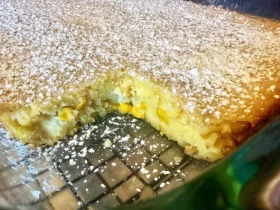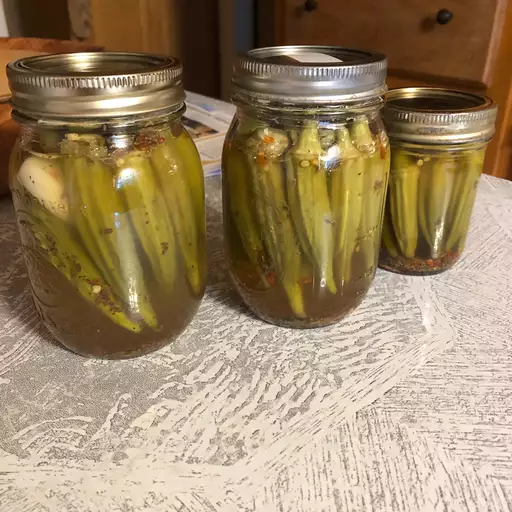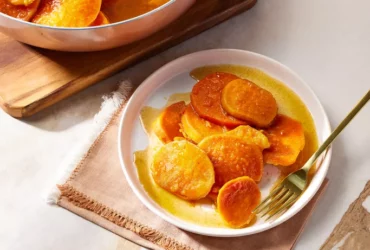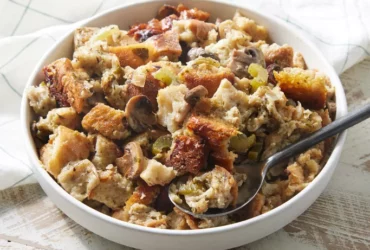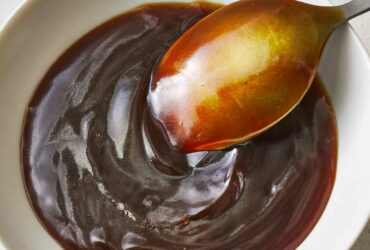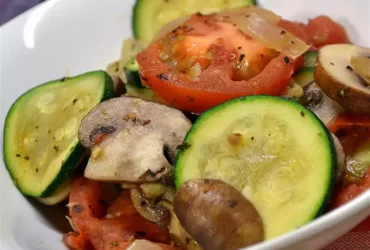Ingredients
Cucumbers (or okra)
Okra is a versatile ingredient that originates from Africa and has since been adopted by many cultures around the world, including those in Southern United States where it is often pickled and used as a condiment.
The okra plant produces small, green or purple pods that are rich in vitamins, minerals, and antioxidants. When harvested at the right stage of maturity, okra pods can be used in various ways, such as steaming, roasting, sautéing, or pickling.
Pickling is a popular method for preserving okra and enhancing its flavor and texture. In Grandma Oma’s recipe, okra is typically pickled in a brine solution with spices and herbs to create a tangy and slightly sweet condiment that complements many Southern dishes.
For this recipe, you will need the following ingredients:
- Cucumbers or Okra: Fresh okra pods are essential for Grandma Oma’s recipe. Select small to medium-sized pods with a tender texture and no signs of browning or mold.
- White Vinegar: White vinegar provides the acidity needed to preserve the okra and create its distinctive flavor. You can use plain white vinegar or apple cider vinegar as a substitute.
- Sugar: Sugar helps balance the acidity of the vinegar and adds sweetness to the pickled okra. You can adjust the amount of sugar to your taste, but keep in mind that using less sugar may result in a more tart flavor.
- Water: Water is added to dilute the brine solution and make it easier to pour over the okra. Be sure to use filtered or distilled water for the best results.
- Salt: Salt enhances the flavor of the pickled okra and helps preserve it by drawing out moisture. Use plain table salt or kosher salt, but avoid using sea salt as it can be too coarse.
- Spices and Herbs: Grandma Oma’s recipe typically includes a mix of spices and herbs like garlic, onion powder, paprika, mustard seeds, dill weed, and pickling spice. Feel free to adjust the proportions or omit any ingredients that you don’t have on hand.
Remember to store your pickled okra in an airtight container in the refrigerator for optimal flavor and shelf life. Enjoy Grandma Oma’s delicious pickled okra as a condiment, side dish, or topping for various Southern favorites like fried chicken, burgers, or salads!
1 pound fresh okra pods
For Grandma Oma’s pickled okra recipe, you will need to gather a specific type and quantity of fresh okra pods. The ideal okra for pickling should be firm, glossy, and about 2-3 inches in length.
Selecting the right okra is crucial as it directly affects the flavor, texture, and overall quality of your pickled okra. You can usually find okra at most grocery stores or farmers’ markets during the warmer months when it’s in season.
A good rule of thumb for choosing fresh okra is to look for pods with no signs of wilting, browning, or bruising. Avoid selecting okra with open flowers or those that have already begun to dry out, as they may not retain their desired crunchiness.
For this recipe, you will need a total of 1 pound (450 grams) of fresh okra pods. This amount should yield about 2-3 cups of sliced okra once trimmed and cut into the required shape.
When trimming the okra, be sure to remove any tough or woody ends, as well as the calyx at the top of each pod (the tiny little leaves that resemble a tiny flower). This will help prevent any bitterness from transferring to your pickled okra during the cooking process.
Pickling Liquid
The key to making delicious pickles lies in selecting the right ingredients and creating a flavorful Pickling Liquid. In the case of Grandma Oma’s Pickled Okra Recipe, we’ll focus on gathering essential components that will bring out the best in these tangy and crunchy treats.
For a basic Pickling Liquid, you’ll need a combination of acid (to preserve and add flavor), sugar (to balance the acidity and enhance sweetness), salt (to draw out moisture, prevent spoilage, and add depth), and spices (to give the pickles their unique taste). In Grandma Oma’s recipe, we’ll be using white vinegar, sugar, salt, and a blend of aromatic spices.
White Vinegar
A crucial ingredient in creating an acidic environment that inhibits bacterial growth. White vinegar is the preferred choice due to its clear, neutral flavor and versatility. It adds a tangy taste without overpowering the natural sweetness of the okra.
Sugar
Granulated sugar helps balance the acidity from the vinegar, preventing it from becoming too sharp or overwhelming. Sugar also contributes to browning during the cooking process, resulting in an appealing golden color for your pickles.
Table Salt
A coarser salt is best avoided as it can lead to uneven distribution and may cause the pickles to develop an unpleasant texture. Table salt dissolves easily and is essential for preventing spoilage by drawing moisture from the okra, while also enhancing flavors.
The Sour Spice Blend – composed of garlic powder, onion powder, ground mustard, paprika, black pepper, dill weed, and a pinch of cayenne pepper – adds an unmistakable flavor profile to Grandma Oma’s pickled okra. Adjust the proportions to suit your personal taste preferences.
In summary, when creating the Pickling Liquid for Grandma Oma’s Pickled Okra Recipe, you will combine vinegar, sugar, salt, and spices in a well-balanced ratio that complements the natural sweetness of okra. The acidity helps preserve the pickles while developing their flavor.
1 cup white vinegar
Vinegar is a crucial ingredient in Grandma Oma’s Pickled Okra Recipe, and specifically, 1 cup of white vinegar is called for.
White vinegar is a type of distilled vinegar that is made from grain or starch-based materials and has undergone fermentation.
The acidity level of white vinegar makes it an excellent choice for pickling vegetables like okra, as it helps to preserve them by creating an environment that is not conducive to the growth of bacteria and other microorganisms.
When choosing a white vinegar for Grandma Oma’s recipe, look for one that has no added flavorings or preservatives, as these can affect the taste and texture of the pickled okra.
Some popular brands of white vinegar include Heinz, Clabber Girl, and Walmart Great Value, among others.
Types of White Vinegar: A Comparison
- Heinz White Vinegar: Known for its purity and lack of additives, Heinz is a popular choice for cooking and pickling.
- Clabber Girl White Vinegar: This brand is known for its high quality and affordability, making it a great option for those on a budget.
- Walmart Great Value White Vinegar: A store-brand option that offers excellent value for the price, Walmart’s white vinegar is a popular choice among cooks and bakers.
In addition to the type of white vinegar used, other ingredients in Grandma Oma’s recipe include sliced okra, salt, sugar, pickling spice blend, garlic powder, onion powder, mustard seeds, coriander seeds, dill weed, and black peppercorns. Each ingredient plays a crucial role in creating the unique flavor and texture of this classic pickled okra recipe.
When working with vinegar, it’s essential to note that the acidity level can vary depending on the type and brand used.
For Grandma Oma’s Pickled Okra Recipe, 1 cup of white vinegar is used as a preservative to help maintain the freshness and crunchiness of the okra.
The acidity level of white vinegar makes it an ideal choice for pickling vegetables like okra, helping to prevent spoilage and preserve the natural flavor and texture of the ingredient.
1/2 cup water
The key to creating a delicious and tangy pickling liquid for Grandma Oma’s Pickled Okra Recipe lies in selecting the right ingredients. Among these, water plays a crucial role as a primary solvent that helps dissolve other ingredients and facilitates the extraction of flavors from the okra.
In this recipe, you will need 1/2 cup of water. This is a moderate amount of liquid that balances out the acidity and sweetness introduced by other ingredients without overpowering them.
The water should be fresh and free from impurities. Using filtered or purified water can enhance the overall taste and aroma of the pickling liquid, while also ensuring food safety.
1 tablespoon salt
The star of our recipe today, Grandma Oma’s Pickled Okra, requires a variety of ingredients to bring out its tangy flavor and crunchy texture. Below are the essential items you’ll need:
- Okra: 1 large bunch or approximately 2 pounds of fresh okra pods
- Water: 4 cups of water, filtered or tap
- Vinegar: 2 cups of white vinegar or apple cider vinegar
- Salt: 1 tablespoon salt, preferably kosher or sea salt
- Spices and flavorings: A pinch of whole black pepper and a few sprigs of fresh dill weed (optional)
In terms of the 1 tablespoon salt in our recipe, it’s worth noting that this quantity will help to enhance the overall flavor profile of our pickled okra. The type of salt used can also make a difference – kosher or sea salt tends to have a milder flavor and a coarser texture than regular table salt.
1 teaspoon whole black peppercorns
The use of whole black peppercorns in Grandma Oma’s Pickled Okra Recipe is a crucial element that enhances the flavor and aroma of the dish. The 1 teaspoon of whole black peppercorns serves as a key ingredient in this recipe, and its importance cannot be overstated.
Here are some reasons why whole black peppercorns play such a vital role in Grandma Oma’s Pickled Okra Recipe:
- Flavor enhancement: Whole black peppercorns add a robust, slightly bitter flavor to the pickled okra that complements its natural sweetness.
- Aroma: The aroma of whole black peppercorns is released during cooking and adds depth to the dish.
- Texture: Whole black peppercorns have a distinct texture that provides a nice contrast to the crunchy pickled okra.
- Culinary tradition: In many traditional recipes, whole spices like black peppercorns are used as a matter of course to add flavor and depth to dishes.
Whole black peppercorns can be found in most grocery stores or online. They come from the Piper nigrum plant, which produces small, unripe berries that are dried until they turn dark brown and hard. These berries contain the peppercorn’s characteristic flavor and aroma compounds.
To use whole black peppercorns in Grandma Oma’s Pickled Okra Recipe, you can simply add them to the pickling liquid along with the other spices and herbs. As the okra cooks, the flavors of the peppercorns will infuse into the dish, creating a rich, savory flavor that is characteristic of traditional pickles.
Some tips for working with whole black peppercorns include:
- Use fresh peppercorns: Fresh peppercorns have a more vibrant aroma and flavor than old or stale ones.
- Avoid overusing peppercorns: Whole black peppercorns are potent, so use them sparingly to avoid overpowering the dish.
- Grind peppercorns as needed: If you need a fine grind of pepper for the recipe, simply grind the whole peppercorns in a spice grinder or mortar and pestle.
In summary, whole black peppercorns are an essential ingredient in Grandma Oma’s Pickled Okra Recipe. Their robust flavor, aroma, texture, and culinary tradition make them an ideal addition to this dish. By using fresh, high-quality whole black peppercorns, you can create a rich, savory flavor that is characteristic of traditional pickles.
Instructions
Packaging the Okra
- The packaging process for Grandma Oma’s pickled okra recipe requires careful attention to detail to ensure that the product arrives at the consumer’s doorstep in perfect condition.
Here are the step-by-step instructions for packaging the okra:
Sorting and Selection
- Select fresh, tender okra pods with no signs of blemishes or damage. Inspect each pod carefully to ensure that it meets Grandma Oma’s high standards.
Quality control is crucial at this stage as any subpar product will negatively impact the customer experience.
Cleaning and Sanitizing
Rinse each okra pod thoroughly with cold water to remove any dirt or debris. Sanitize the pods using a mild detergent solution, making sure to rinse them well afterwards.
Preparing for Packaging
Dry the sanitized okra pods thoroughly with paper towels to prevent moisture from seeping into the packaging materials.
Packaging Materials
- Vacuum-seal bags or containers with an airtight seal to preserve freshness and prevent spoilage
- Packing paper or inserts for cushioning and preventing damage during transit
- Labels with clear instructions for storage, handling, and consumption
Final Packaging Steps
- Place each okra pod in a vacuum-seal bag or container, making sure to remove any excess air to prevent spoilage.
- Wrap the packaged okra pods in packing paper or inserts for added protection during transit.
- Attach labels with clear instructions for storage, handling, and consumption to each package.
Quality Control (Again)
- Inspect each package carefully before sealing it for shipment to ensure that all items meet Grandma Oma’s high standards.
- Make any necessary adjustments or replacements before finalizing the packaging process.
Wash and trim the okra pods, removing any blemishes
When it comes to creating a delicious batch of pickled okra using Grandma Oma’s tried-and-true recipe, the first step is to carefully wash and trim the okra pods. This process not only ensures that the final product tastes its best but also helps to remove any imperfections or blemishes that could affect the appearance or quality of the pickles.
To begin washing the okra pods, fill a large bowl or container with cold water and gently add the okra to it. Swirl the okra around in the water to dislodge any dirt or debris that may be clinging to the tender green pods. Allow the okra to soak for about 10-15 minutes, which will help loosen up any dirt and make them easier to clean.
After soaking the okra, drain off the water from the bowl and rinse the okra with fresh cold water to remove any remaining dirt or debris. Once clean, it’s time to trim the ends of the okra pods and remove any blemishes that may be present.
To trim the okra, simply cut off the stem end of each pod, about 1/4 inch from the top. This will help prevent any bitter flavor from seeping into the pickles during the cooking process. Next, inspect each okra pod for any blemishes or imperfections, such as bruises, scratches, or soft spots.
Remove any okra pods that are severely damaged or have visible signs of decay. This will help ensure that your pickled okra turns out flavorful and crunchy, with no unpleasant textures or flavors to ruin the dish. Once you’ve removed any blemished or damaged okra, it’s time to move on to the next step in Grandma Oma’s recipe: preparing the brine for pickling.
Pack the trimmed okra into a clean glass jar, leaving about an inch of space at the top for brine
The art of creating delicious pickles is a cherished tradition that has been passed down through generations, and Grandma Oma’s recipe for pickled okra is no exception.
For this recipe, it’s essential to start with the freshest ingredients possible, which in this case means trimming the okra pods to remove any blemishes or imperfections. The trimming process helps ensure that the okra absorbs flavors evenly and maintains its crisp texture throughout the pickling process.
Once you have trimmed the okra, it’s time to prepare them for packing into a clean glass jar. You can choose either a wide-mouthed mason jar or a regular glass jar with a tight-fitting lid. Make sure the jar is thoroughly cleaned and sterilized before use.
To pack the trimmed okra into the jar, follow these steps:
- Start by packing the okra pods tightly but gently into the clean glass jar, leaving about an inch of space at the top for brine. This will allow you to add the pickling liquid without overfilling the jar.
- As you pack each layer of okra, make sure they are aligned in a way that prevents them from overlapping and creating gaps in the jar.
- Continue packing the okra layers until you reach about an inch from the top of the jar. This will ensure enough space for the brine to cover all the okra pods during pickling.
Now that the okra is packed into the jar, it’s time to create the delicious brine that will give your Grandma Oma’s Pickled Okra its signature flavor and crunchy texture. The next step in this recipe involves mixing together a combination of ingredients such as vinegar, water, salt, sugar, garlic, and spices to create the perfect pickling liquid.
For the best results, be sure to follow all the steps in Grandma Oma’s Pickled Okra Recipe carefully, from trimming the okra pods to packing them into a clean glass jar and creating the delicious brine that gives this recipe its unique flavor. With these instructions, you’ll be able to create your own homemade pickled okra just like Grandma Oma used to make.
Preparing the Brine
To prepare the brine for Grandma Oma’s pickled okra recipe, it’s essential to follow these steps carefully to ensure the best flavor and texture for your pickles.
The first step in preparing the brine is to combine the water, salt, and sugar in a large saucepan. The ratio of water to salt and sugar should be 4:1, with 4 parts water to 1 part salt and sugar combined. This will help to create a balanced flavor profile for your pickles.
Next, add the white vinegar and spices, such as black peppercorns, dill seeds, and mustard seeds, to the saucepan. The amount of spices can be adjusted to taste, but a general rule of thumb is to use 1 teaspoon of each spice per quart of brine.
Place the saucepan over medium heat and stir until the salt and sugar have dissolved. This should only take a few minutes, as the mixture will start to boil once the solids are dissolved.
Once the brine is hot and clear, remove it from the heat source and let it cool to room temperature. This step is crucial, as you don’t want to add the okra to hot brine, as this can cause it to become overcooked and mushy.
While the brine is cooling, prepare your okra by washing and trimming it. Remove any stems or leaves that are blemished or wilted, as these will not pickle well. You want to use only fresh, firm okra for this recipe.
Once the brine has cooled, pack the okra into a clean glass jar or container with a tight-fitting lid, leaving about 1 inch of space at the top. Pour the cooled brine over the okra, making sure that each piece is fully submerged in the liquid.
Seal the jar and store it in the refrigerator to allow the pickling process to begin. The longer you let the okra sit in the brine, the tangier it will become. Typically, it takes at least 24 hours for the flavor to develop fully, but this can be adjusted to your taste preferences.
When you’re ready to eat your pickled okra, simply serve it chilled or at room temperature, garnished with fresh herbs and spices if desired. Enjoy!
Combine the vinegar, water, salt, and black peppercorns in a saucepan, bringing it to a boil over medium heat
To create the brine for Grandma Oma’s pickled okra, you will need to combine several ingredients in a saucepan.
First, pour 1 cup of white vinegar into the saucepan.
Next, add 1/2 cup of water to the saucepan with the vinegar.
Add 1 teaspoon of salt to the mixture, stirring it in to dissolve completely.
Now, add a few sprigs of fresh black peppercorns, about 6-8 whole peppercorns, to the saucepan. You can adjust the amount according to your desired level of spiciness.
Place the saucepan over medium heat on your stovetop and bring it to a boil.
Once boiling, reduce the heat to a simmer and allow the brine to cook for about 10-15 minutes. This will help the flavors meld together and create a nice consistency for the pickling liquid.
Why this is important
- This step helps to create a flavorful base for the pickles.
- The vinegar acts as a preservative, helping to extend the shelf life of the pickled okra.
- The salt enhances the flavor and helps to draw out moisture from the okra.
Tips and Variations
- For a spicier brine, use more black peppercorns or add in some red pepper flakes.
- To make a sweeter brine, reduce the amount of vinegar and add in some sugar or honey.
Safety Precautions
- Always use a saucepan that is large enough to hold all of the ingredients without overflowing.
- Maintain medium heat throughout the cooking process, as high heat can cause the brine to boil over or burn easily.
Canning the Okra
Heat Processing
Canning okra requires careful attention to heat processing to ensure that the jars are properly sterilized and sealed, preventing spoilage and allowing for long-term storage.
The first step in canning okra is to prepare the okra by trimming its ends, cutting it into uniform pieces, and packing them tightly into clean, hot glass jars. It’s essential to leave about 1/2 inch of headspace between the okra and the lid.
Next, prepare a brine solution by combining water, vinegar, salt, and any additional flavorings or spices desired for Grandma Oma’s pickled okra recipe. Bring this mixture to a boil in a saucepan over high heat, stirring occasionally, until it reaches 212°F (100°C). This step is crucial for killing off any bacteria that may be present in the okra or brine.
Once the brine has cooled slightly, pour it over the okra, making sure that all the pieces are completely covered. Use a clean utensil to remove any air bubbles and ensure proper contact between the liquid and the food.
To process the jars in a boiling water bath canner, fill a large pot with enough water to cover the tops of the jars by at least 1 inch. Bring this water to a rolling boil over high heat. Carefully lower the jars into the pot using a clean utensil or jar lifter.
Process the jars for 10-15 minutes from the time the water returns to a boil after adding the jars. This step is essential for ensuring that all the bacteria in the okra and brine are killed, allowing the food to be safely stored for up to 12 months.
After processing the jars, turn off the heat and let them sit for 5-10 minutes before removing them from the pot with a clean utensil or jar lifter. Let the jars cool to room temperature undisturbed for 24 hours to allow the lids to seal properly.
Once the seals have set, remove the jars from their storage location and check the seals by pressing on the center of each lid. If the lid does not move up and down easily when pressed, it has sealed correctly. Store the sealed jars in a cool, dark place for long-term storage and enjoy Grandma Oma’s pickled okra recipe throughout the year!
Pack the hot brine into the jar with the okra, covering it immediately
Cleaning and preparing the okra for canning is crucial to ensure its quality and safety. Begin by washing the okra pods in cool running water, then gently scrubbing them with a soft brush to remove any dirt or debris.
Next, cut off the stems of the okra pods, leaving about 1/4 inch at the top. Trim any blemishes or bruises from the pods, and discard any that are not suitable for canning.
Now, it’s time to prepare the hot brine. In a large saucepan, combine vinegar, water, salt, sugar, garlic powder, and pickling spice. Bring the mixture to a boil over high heat, stirring occasionally, then reduce the heat to medium-low and simmer for 10-15 minutes.
Pack the hot brine into the jar with the okra, leaving about 1/4 inch headspace at the top of each jar. Make sure the okra pods are completely covered in the brine, as this will help prevent spoilage and promote the growth of beneficial microorganisms.
Using a clean utensil, such as a plastic or wooden spoon, gently press down on the okra pods to remove any air pockets and ensure they are submerged in the brine. Be careful not to bruise or damage the pods during this process.
Remove any air bubbles that may have formed in the jar by running a clean utensil around the edges of the lid and then wiping the rim with a clean cloth to create a tight seal.
Close the jar and process it in a sterilized water bath for 10-15 minutes, adjusting for altitude as necessary. Remove the jar from the boiling water and let it cool on a wire rack.
Process the jars for 10 minutes in a boiling water bath
To can Grandma Oma’s Pickled Okra, you will need to follow a series of steps to ensure that your jars are properly sterilized and sealed.
First, gather all of your equipment and ingredients, including the okra pods, vinegar, sugar, water, salt, and spices.
Next, prepare the jars by washing them in hot soapy water and rinsing thoroughly. This will remove any debris or residue that may be present on the jars.
Place the clean jars into a large pot or canner, making sure they are covered with at least 1 inch of water. Bring the water to a boil and then reduce heat to a simmer for 10 minutes. This step is known as “processing” the jars.
During this time, the heat from the boiling water will help to sterilize the jars and ensure that they are ready for filling with the pickled okra.
Once the processing time has elapsed, carefully remove the jars from the pot using a jar lifter or tongs. Place them on a clean towel or cooling rack to cool.
After the jars have cooled slightly, you can check the seals by pressing on the top of each jar. If the lid does not move and the seal is tight, the jar is sealed properly.
Let the jars sit for 24 hours before storing them in a cool, dark place. The pickled okra will be ready to eat in a few days and can be stored for up to 12 months.
Let the jars cool before storing them in a dark, cool place
The final step in preserving Grandma Oma’s pickled okra recipe involves canning the okra to ensure it remains fresh and flavorful for months to come. To begin, make sure all the necessary equipment and supplies are ready and within reach. This includes clean jars with new lids, a large pot or water bath canner, and a rack specifically designed for canning.
Prepare the okra by cutting off the stems at an angle and trimming any long, fibrous threads from the ends. Wash the okra in cold running water to remove any dirt or debris, then dry them thoroughly with paper towels. Next, pack the okra into the prepared jars, leaving about a half-inch of space between each piece and one inch at the top.
Prepare the pickling solution by combining Grandma Oma’s secret ingredients, including salt, sugar, vinegar, and spices. Bring the solution to a boil in a large saucepan, then reduce the heat to a simmer. Pack a few sprigs of fresh dill or a pinch of pickling spice into each jar, followed by some of the pickled okra.
Pour the hot pickling solution over the okra, making sure to cover all the pieces completely. Remove any air bubbles that form by running a non-metallic utensil, such as a plastic spatula or chopstick, around the inside of the jar. Wipe the rim with a clean, damp cloth and apply the sterilized lid.
Process the jars in a boiling water bath canner for 10-15 minutes to ensure that they are properly sterilized and sealed. Remove the jars from the canner and let them cool on a wire rack or tray. Once the jars have cooled, check the seals by pressing on the top of each lid – if it doesn’t move at all, the seal is good.
Let the jars cool completely before storing them in a dark, cool place. Avoid storing them near direct sunlight or heat sources, as this can cause the pickling solution to spoil or the okra to become discolored. The jars should now be ready for use within several weeks and can be stored at room temperature until opened.
When you’re ready to enjoy your homemade pickled okra, simply remove a jar from storage and give it a good shake to redistribute the liquid. Serve chilled or at room temperature, and enjoy the delicious flavors of Grandma Oma’s secret recipe!
- Best Clay Alternatives for 2025 - April 22, 2025
- Best Leadfeeder Alternatives for 2025 - April 22, 2025
- Best Snov.io Alternatives for 2025 - April 21, 2025


